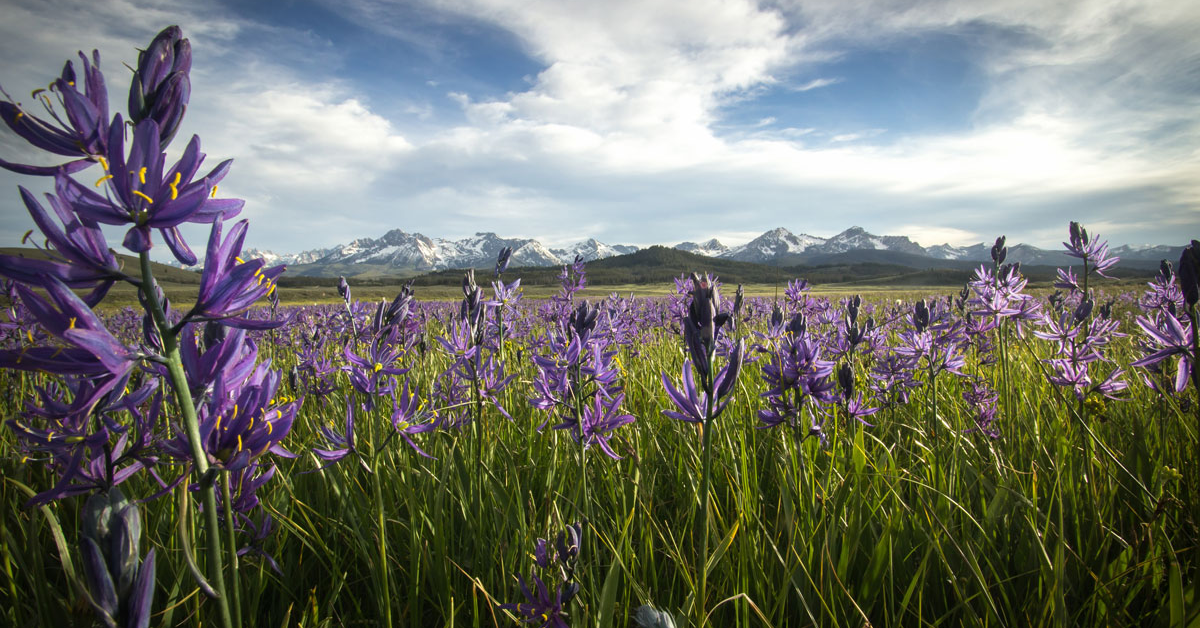
The 7 Best Places to See Wildflowers in the Sawtooths
Stanley’s natural surroundings are often described as rugged. The tiny town is somewhat isolated, as the nearest “big” city, Boise, is nearly three hours away. And the craggy Sawtooth Mountains are visible from the town, which sits more than 6,200 feet above sea level. Indeed, at first glance, Stanley doesn’t seem like the sort of place you’d find anything delicate.
But this mountain outpost is full of surprises. Far below the jagged peaks of the Sawtooth range, mountain meadows near Stanley burst to life in spring and summer with the arrival of gorgeous wildflowers. An abundance of trails near town offer access to the meadows, allowing you to take long hikes or short strolls to enjoy the plants in bloom. To put you on the right path, we’ve highlighted some top spots to see these brilliant displays of color in the Sawtooths.
1. Pettit Lake
Pettit Lake is home to one of the most beloved campgrounds in the Sawtooths, so it’s easy to stay for several days and enjoy abundant opportunities to see wildflowers. For a more solitary backcountry experience, hikers can take on the 18-mile Pettit and Toxaway Lakes Loop, which makes a phenomenal overnight or three-day backpacking trip. In the spring, the trail is teeming with trillium and cheerful arrowleaf balsamroot. (Don’t forget to bring bug repellent for this hike to ward off the persistent mosquitoes in the early morning and evening.)
2. Fourth of July Lake
The views of the White Cloud Mountains from the Fourth of July Trail are spectacular, but they’ve got some serious competition from the local flora. The moderate hike to the trail’s namesake lake is just under two miles and gains a little over 600 feet in elevation each way. When you reach the flowers, you won’t be too out of breath to enjoy their beauty. You’ll know you’re getting close to your destination when you’re greeted by countless purple penstemons.
Inspired to see more? Keep hiking for another mile to reach Washington Lake, or set up camp in this scenic alpine valley.
3. Alpine Way Trail
There’s no bad portion of the 17-mile Alpine Way Trail . But in the early summer months—when wildflowers are most likely to bloom in the great numbers—you can’t go wrong with the 8.5-mile section between Iron Creek and Stanley Lake. Wooly sunflowers and beautiful Western columbines dot the landscape along the trail. Bonus: Your wildflower photos will feature the craggy faces of McGown Peak and Mystery Mountain in the background. If you’re headed here in early summer, be prepared for some potentially challenging stream crossings.
4. Bench Lakes Trail
The Bench Lakes are comprised of five alpine lakes, each of which is surrounded by myriad wildflowers during the warmer months. At times, there are so many flowers in bloom that you can actually smell them as you walk along nearby trails. For a moderate, four-mile hike, park at the Redfish Trailhead near Redfish Lake Lodge and take the Fishhook Trail, which leads to the second of the five Bench Lakes. Along the way, you’ll follow a ridge overlooking Redfish Lake, one of the most scenic spots in the Stanley area. Flowers are especially abundant where the Fishhook Trail nears a lake inlet, and higher up you might spy purple camas lily blooms. From the lake, retrace your steps to the Redfish Trailhead.

5. Marshall Lake
The hike to Marshall Lake is best saved for later in the season because there’s often snow on the trail into July. But once the snow melts, hikers are in for sublime solitude and a magical display of flowers. Because this path is less popular than other nearby trails, you’re far more likely to be the only one stopping to smell the proverbial roses. (In this case, they’re more likely to be arrowleaf balsamroot.) Beginning at the Redfish Trailhead parking area, you’ll follow the Fishhook Trail for a little more than 4.5 miles to reach Marshall Lake.
6. White Cloud Loop Trail
Looking for a full tour of all the wildflowers Stanley has to offer? Consider bringing along a checklist for a 28-mile backpacking loop through the White Cloud Mountains, where you’ll likely see a dozen or more flower species. Beginning at the Fourth of July Trailhead, you’ll scramble a bit as you follow a ridgeline and traverse several meadows to sample some of the trail’s best terrain. Keep an eye out for the dazzling scarlet gilia, whose blooms are shaped like little red trumpets.
7. Elk Meadow
From the Elk Mountain Trailhead , it’s an easy two-mile walk over fairly flat terrain to reach Elk Meadow and its abundance of wildflowers. Once you arrive in the meadow itself, keep your wits about you—the trail disappears entirely before leaving the meadow for Elizabeth Lake. (You’ll also want to keep an eye out for mountain bikers who ride through the meadow as part of a larger loop.) Home to beautiful species like mountain shooting star, yarrow, and slender paintbrush, Elk Meadow offers one of the most spectacular wildflower displays you’ll find anywhere, especially in late June.
Whether you’re a photographer, a wildflower enthusiast, or a nature lover who appreciates the colors of spring, you’ll have a memorable time exploring the trails near Stanley. From day hikes to week-long treks, there are numerous opportunities to visit vast meadows that transform into seas of gold, purple, and pink when warmer weather arrives. The brilliant fields offer a stark contrast to the high peaks of the Sawtooth Mountains cutting a fierce image in the blue sky. But the wildflowers remind us that nature is just as striking when it shows its softer side.